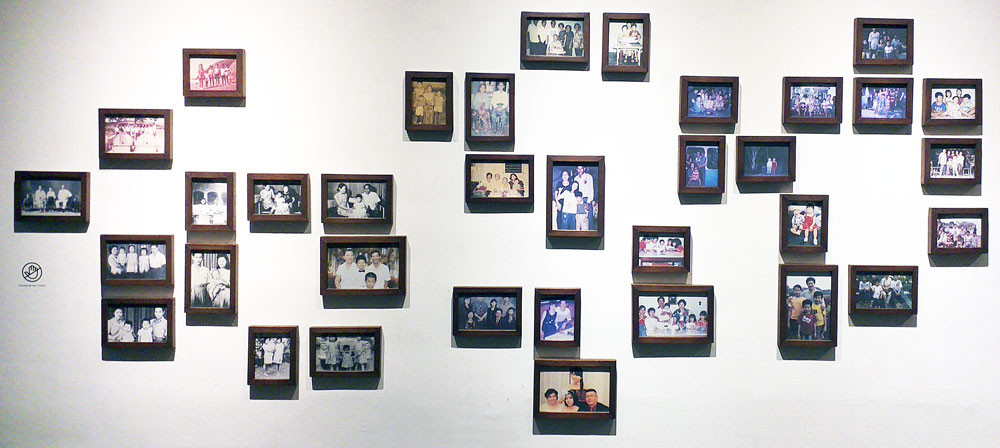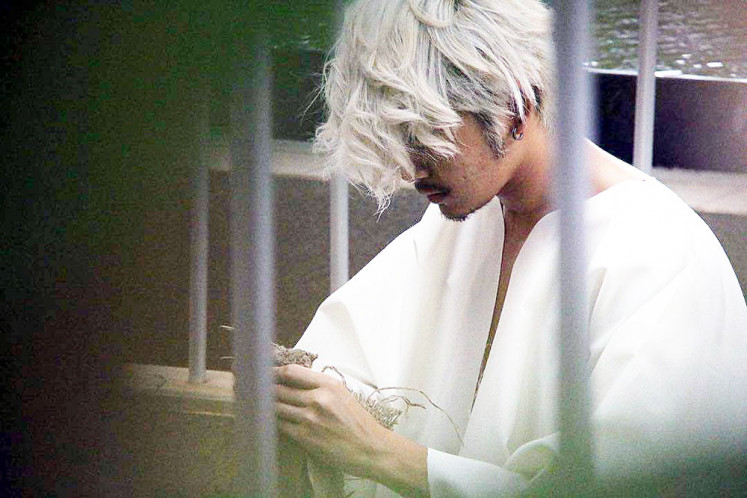Popular Reads
Top Results
Can't find what you're looking for?
View all search resultsPopular Reads
Top Results
Can't find what you're looking for?
View all search resultsExi(s)t: Young artists deconstruct history through their own lens
Running for seven years straight, the annual exi(s)t exhibition series at Dia.Lo.Gue Artspace in Kemang, South Jakarta, has become a beacon of creativity and experimentation for Jakarta’s young contemporary artists.
Change text size
Gift Premium Articles
to Anyone
H
eld from Dec. 6, 2018, to Jan. 13, the exi(s)t exhibition features artwork curated by Evelyn Huang and Stella Katherine, who chose a topic focusing on the dissection and deconstruction of history and the exploration of alternative viewpoints or scenarios within history.
Myths, written traditions, politics, epic events as well as personal narration all fare through various mediums as performance, text, collage, film, light, displays and music in the works of the featured artists; Alexandra Karyn, Aziz Amri, Ella Wijt, Rummana Yamanie, Semburat, Sherchle, Tandika Cendrawan and Yovista Ahtajida.
Rummana was one of the artists who performed during the exhibition’s opening night and she addressed, through her performance called “The Flaming Womb”, the overlooked roles that certain females held in Indonesian history, where they occupied jobs and roles that were a stereotypically male position.
She pinpointed the significance of three historical and almost mythically legendary women; Ken Dedes, Gayatri Rajapani and Estri Mangkunegaran.
Dedes was the legendary warlock and queen of the Singosari Kingdom, Gayatri the consort to the powerful Majapahit Kingdom king Kertarajasa Jayawardhana while Estri was a Javanese soldier known for her bravery and skillful fighting during the 1700s.
Despite of the three women’s prowess, they were also expected to do the things women were traditionally supposed to do in their time, including dancing, painting and cooking. Rummana’s analysis on these three figures brought out a history overlooked generally to give these women their rightful places in history.
“The aim of my piece is to celebrate the multiple roles of women, many of whom have been overlooked because of the patriarchal nature of Indonesian society,” she said.
Rummana, however, denied that her main intention was to promote gender equality or draw inspiration from feminism and stated that she only saw her subject matter as “pure history”.
“Nasyid Goes Punk Vol. 1” by Yovista Ahtajida. (The Jakarta Post/Iqbal Yuwansyah)Her performance piece on the exhibition’s opening night involved throwing herself onto a slab of clay, which took the shape of a kind of entryway as she slowly immersed herself within the clay itself, symbolizing unity with the earth that history has tilled.
Another performance piece that was featured on opening night was by Aziz, who aimed at exploring the forgotten historical travesties of human zoos.
Drawing inspiration from erased colonial crimes, Aziz’s piece aimed at empathizing with the human subjects that were forced into these zoos by their captors. These displays were usually prominent in France, the Netherlands, the United Kingdom and Belgium, which at the time had absolute power over their colonies. Indonesians were not excluded from this frightening practice as the Dutch often brought Indonesians back to the Netherlands as sideshows and street showcases for Europeans to ogle.
“When I talk about this to people, a lot of them aren’t aware that such a thing happened,” Aziz said.
“It’s frightening to realize the kind of humiliation and lack of humanity that these people were subjected to, all in the name of amusing the Europeans’ thirst for exoticism.”
Aziz’s performance had him become zombie-like and lifeless in a makeshift cage set up on Dia.Lo.Gue’s backyard, bearing only white cloth and moving incredibly slowly to and inside the cage, where he cut pieces of string from a wheel that symbolized how the subjects were forced to weave cloth as a spectacle for an unappreciative crowd.
Through Aziz’s performance, he tried to create the invisible barrier between colonizer and the colonized. Everyone present at his rain-soaked performance could only ogle and stare, but thankfully did not heckle or view Aziz inhumanely as the Europeans did in the past.
“Am I able to embody the primal ape I am, and viewed by them?” he asked.
“Jardin Zoologique D’acclimatation” by Aziz Amri. (The Jakarta Post/Iqbal Yuwansyah)Other artists took more philosophical approaches toward their idea of alternative history.
Poet Alexandra opted to address the fact that history is something perpetual; a process that never stops through her text-based work in the form of poetry and a hundred newspapers, symbolizing the “archive of history”, that feature self-written articles pinpointing her current “history” of being an art teacher.
Meanwhile, Tandika explored through “Usia Sebuah Nama Melebihi Nafas” (A Name Lives Longer Than Breath) the lost art of Chinese nomenclature, referring to the turbulent time for the Chinese minority in Indonesia during the 1998 riots where members of the minority were forced to abandon their Chinese names and adopt something more Indonesian sounding.
Yovista explored his annoyance at the commodification of Islam in Indonesia, drawing from his experiences joining an Izzatul Islam musical group during college of which he discovered the lyrics were very similar in nature to the antiestablishment themes found in punk rock music.
The artists’ unique explorations and multiple perspectives into the concept of history and how one views and constructs it that makes this latest edition of exi(s)t so compelling. It offers a chance for the artists to not only explore themselves but also use their explorations in shaping up a world that they create or view.
“Here at exi(s)t we are concerned more with the process of art rather than the result,” exi(s)t cofounder and seminal artist, FX Harsono, said.
Harsono added alternative platforms such as exi(s)t encouraged a deeper understanding of idea construction in a way that many formal educational institutions never have or will ever do so.
“The way formal art educational institutions are structured; they are unprepared to face the rapid development of contemporary art in Jakarta. We need an alternative education on this development to really think about [Indonesia’s] contribution to global art.”













